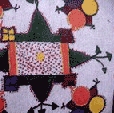The Banjaras of Madhya Pradesh — found in the districts of Malwa and Nimar — have their own distinct style of embroidery. They embroider the surface of the material, creating designs according to the weave of the cloth. The items embroidered are rumals (kerchiefs), batuas (money bags), borders for cholis (blouses), ghagras (skirts) and odhnis . The inside square of the rumal is entirely covered with embroidery. A stem stitch, done horizontally instead of vertically, is used. The needle pierces a particular area between the warp and the weft threads from below, and the thread after crossing two warp threads and weft threads is again inserted into the material; this time it comes out on the right side in line with the first stitch directly below where it ended. The patterns are geometrical and designs are created by varying colours and stitches, to give textured effects. Some motifs are emphasised by the cross-stitch and closely done herring-bone stitches divide the design into squares. The border of the rumal does not have an overall pattern but instead a running design done by counting the threads. The angular designs are achieved by vertical stitches. The inner embroidery of the rumal is similar to the embroidery done by the Mathurai tribe of Andhra Pradesh, and the embroidery at the border is similar to that found in north Bihar. Like the Mathudias of Andhra Pradesh, tassels of different shapes and forms are used. This craft is also practised by the Gondolia tribes of Malwa region, who originate from Rajasthan.


